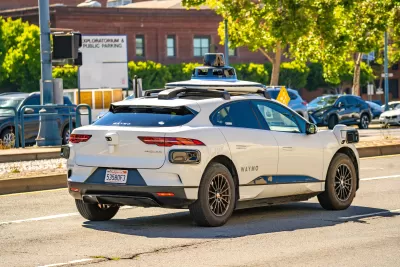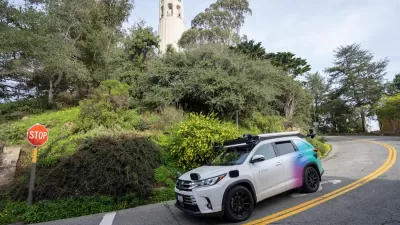Local officials say autonomous cars are not yet safe enough to be permanently deployed across the entire city.

As autonomous taxi companies push for deployment of their self-driving fleets in U.S. cities, city officials and transportation agencies in San Francisco are asking the state to delay the expansion of these services, citing safety and congestion concerns. As Jared Brey explains in Governing, “The stakes are high for all of San Francisco’s street users, and especially for public transit, says Jeffrey Tumlin, director of transportation for the SFMTA.”
“In May, the California Public Utilities Commission issued draft resolutions that would allow Waymo and Cruise, both companies offering self-driving taxi services, to ‘offer passenger service in [their] autonomous vehicles without a safety driver present throughout the city of San Francisco, at all hours of day or night.’” Since then, the vehicles have blocked traffic, stopped dangerously in the middle of the street, driven in transit-only lanes, interfered with emergency response situations, and, in one case, killed a dog.
Public transit officials worry autonomous cars will further disrupt traffic and transit service as transit struggles to recover its ridership and are calling for more data on their safety before they are deployed full-time. The ride-hailing and shared mobility companies that came before autonomous car operators often had combative relationships with cities and regulatory agencies.According to research engineer Tejas Santanam, “Autonomous-vehicle services should take a different tack … working with public agencies to address their needs instead of treating them as obstacles.”
FULL STORY: Why San Francisco Transit Wants a Slower Rollout of Driverless Taxis

Alabama: Trump Terminates Settlements for Black Communities Harmed By Raw Sewage
Trump deemed the landmark civil rights agreement “illegal DEI and environmental justice policy.”

Planetizen Federal Action Tracker
A weekly monitor of how Trump’s orders and actions are impacting planners and planning in America.

Why Should We Subsidize Public Transportation?
Many public transit agencies face financial stress due to rising costs, declining fare revenue, and declining subsidies. Transit advocates must provide a strong business case for increasing public transit funding.

Understanding Road Diets
An explainer from Momentum highlights the advantages of reducing vehicle lanes in favor of more bike, transit, and pedestrian infrastructure.

New California Law Regulates Warehouse Pollution
A new law tightens building and emissions regulations for large distribution warehouses to mitigate air pollution and traffic in surrounding communities.

Phoenix Announces Opening Date for Light Rail Extension
The South Central extension will connect South Phoenix to downtown and other major hubs starting on June 7.
Urban Design for Planners 1: Software Tools
This six-course series explores essential urban design concepts using open source software and equips planners with the tools they need to participate fully in the urban design process.
Planning for Universal Design
Learn the tools for implementing Universal Design in planning regulations.
Caltrans
Smith Gee Studio
Institute for Housing and Urban Development Studies (IHS)
City of Grandview
Harvard GSD Executive Education
Toledo-Lucas County Plan Commissions
Salt Lake City
NYU Wagner Graduate School of Public Service





























